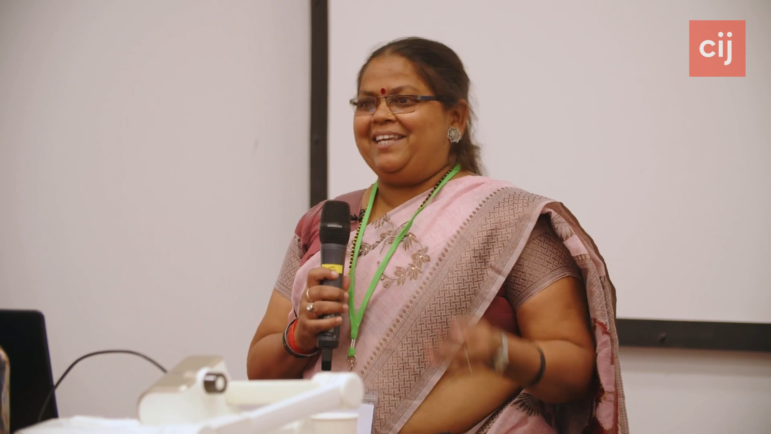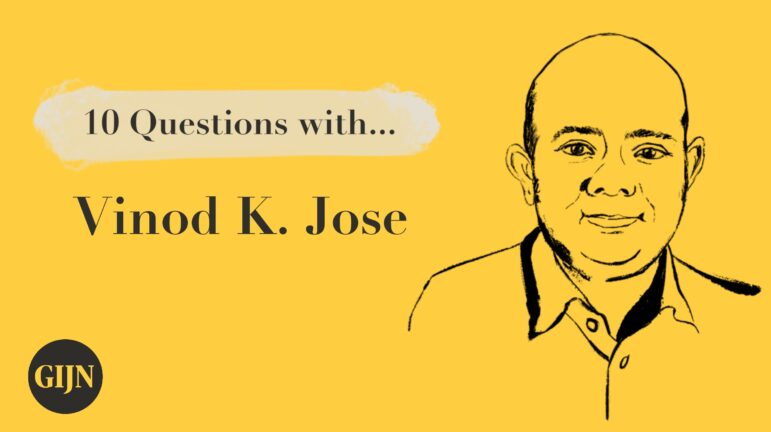

Image: GIJN
Spyware Deals, China’s Border Encroachment, Toxic Cough Syrup: 2023’s Best Investigative Stories in India
Read this article in
The press in India has faced unprecedented threats and oppression in the last few years. According to Reporters Without Borders annual analysis, press freedom in the country has fallen significantly of late, from 133rd in the world in 2016 to 161st out of 180 countries in 2023. Leading media houses such as the BBC were raided and several members of the press were charged with criminal conduct, including journalists from news organization Newsclick, who were arrested and charged for violating the Unlawful Activities Prevention Act. This draconian law is normally applied to terrorist cases, but in the last nine years 16 journalists were prosecuted under the UAPA and seven remain in prison.
Tough working conditions coupled with state pressure on legacy media has also led to a notable decrease in the number of investigative stories. While the legacy media — often dubbed “Godi Media’’ (lapdog journalism) for its propagandist nature — has been an important tool for the ruling government to win elections, a new generation of digital journalism sites has pushed back on this trend. These sites, which include channels on YouTube, are willing to be critical of the dominant political party — and have started to get traction. The limited resources available to them make investigative journalism an ongoing challenge, but many have still done stories exposing the powerful people associated with the government. Here is a list of such stories.

According to the BBC, at least 60 Indians committed suicide after being abused and threatened for failing to repay money borrowed from online, easy-to-get loan apps. Image: Screenshot, BBC
The COVID-19 pandemic and three related nationwide lockdowns ignited skyrocketing unemployment and economic turmoil among both the country’s poor and middle class. To take advantage of this widespread financial hardship, many instant loan apps sprang up, targeting vulnerable people with enticing offers. However, these mostly online, easy-to-get loans came with stringent conditions if the borrower defaulted on repayment. What looked like a normal loan often masked little more than a blackmail scam, where those who couldn’t make their payments were trapped and then humiliated. The scheme targeted not only people across India, but in other countries in Asia, Africa, and Latin America as well.
According to the BBC, at least 60 Indians killed themselves after being abused and threatened for failing to repay one of these loans. A BBC undercover investigation exposed the scandal in India and China and tracked down who was profiting from all this misery.
India’s Invisible Workforce Under Siege
Indian handicrafts are valued across the world for their intricate work and beautiful designs, and women are the backbone of this industry, which is run through a network of both contractual and informal workers. These women are often employed by larger companies through subcontractors, who work as a go-between that enables them to evade stringent labor laws and provide cheap labor.
IndiaSpend, a GIJN member, dug into this sector and discovered that these women workers are paid little and have no legal protection. The low wages and poor legal protection of these female, home-based workers in big cities translate into substandard housing and slum-like working conditions. According to IndiaSpend, this kind of workplace exploitation of women “adversely affects both their occupation and well-being.’’
Chinese Encroachment on Indian Territory Documented With Satellite Imagery

Overview of new Chinese construction activities opposite India’s Uttarkashi. Image: Screenshot, original image courtesy of Planet Lab PBC
Chinese incursions into the Indian border states of Sikkim, Ladakh, and Arunachal Pradesh have been repeatedly denied by the Indian government. The country’s media have also shied away from reporting the reality of the erection of Chinese military villages across the border, despite local reports and opposition claims. However, investigative reporting by India’s leading media house, India Today, exposed the false claims of the Indian government.
Using satellite imagery, India Today published a story that “provides irrefutable evidence confirming the recent claims of construction of military villages.’’ According to the reporting, China built roughly 100 structures violating Indian sovereignty over a period of just one month. An embarrassing revelation for the ruling government, these Chinese outposts are an obvious cause of strategic concern, as the Indian military warns that they are “capable of accommodating an increased deployment of troops, leveraging the advantageous topography of the region.’’
Fortified Deals: Behind the Questionable Decision to Feed Half of India Fortified Rice

Pratima Munda of Kuchiyasholi, Jharkhand, holds a plate of fortified rice served under mid-day meal scheme to children in the village. Photo: Shreegireesh Jalihal, Reporters’ Collective
The Reporters’ Collective — a consortium of investigative reporters, and a GIJN member — published a three-part series exposing a scheme where fortified rice was fed to half of India despite warnings from experts about its potentially adverse effect on children. The investigation revealed that the Netherlands-based company Royal DSM NV, one of the world’s most prominent producers of fortified rice premix powder, used a web of six organizations, mainly nonprofits, to influence the Indian government. Thanks to a deal eventually announced by Prime Minister Narendra Modi, the company ensured a massive market for its product, despite public health concerns and the finance ministry calling the move “premature.”
Indian Military Purchases of Pegasus Spyware Revealed

A booth at the 2021 International Defence Exhibition & Conference in Abu Dhabi. Image: Screenshot, Cognyte, The Hindu
Last year, the Pegasus spyware scandal shook the foundations of many countries after a collaboration of investigative journalists exposed the widespread deployment of the platform to target politicians, human rights activists, and the press. Reporting also revealed that many opposition leaders in India, including top journalists, were also targeted by the spyware, igniting a massive controversy and an investigation by a Supreme Court-appointed committee. Throughout, the Modi government denied that it had anything to do with the purchase of the Israeli company NSO’s software.
However, an investigative journalist at The Hindu newspaper used trade data to unearth purchases by the Indian military of similar products. According to the story, a known spyware manufacturer had been supplying computer gear to the Indian military’s Signal Intelligence Directorate (SID) for more than three years.
The Ugly Side of New Delhi Hosting the G20

On a revenue record, a government employee points out a Mehrauli plot, on which a number of “encroachments” have been registered. Image: Screenshot, Mukta Joshi, Article 14
The push to showcase India’s capital New Delhi as a sparkling-clean, world-class city for the participants of the G20 summit this past year had a hidden, ugly side. As part of the beautification efforts, 1,600 homes and buildings were demolished without prior notice or alternative arrangements, leaving more than a quarter million people without a home, almost overnight. Reporters from Article 14 did on-the-ground ground research to tell the tale of illegal demolitions in four localities. These mass removals were done in a span of just three months, contradicting the government’s claims that it followed the law.
Easy Access to Acid Via Online Sellers Amplifies Threat to Indian Women
Acid attacks regularly make headlines in India, as spurned advances, failed relationships, or outright misogyny often result in harm to vulnerable women. In 2013, after public outcry, the Supreme Court of India issued guidelines regarding the sale of acid, mandating that sellers of the products maintain a register with the details of buyers, including their addresses and the quantities sold. But despite this law, online shopping companies have continued to sell acid, providing easy, yet hard-to-trace access to it. An investigative reporter from The Morning Context checked the availability of acid via online platforms and documented how the popular weapon for targeting women remains available on almost all shopping platforms — without any checks or legally required records.
India’s Cough Syrup Testing Regime Has Alarming Blind Spot
Last year, 70 children in the West African country of Gambia died after consuming cough syrup made in India. The World Health Organization linked the deaths back to an Indian manufacturer that had allegedly used a harmful chemical ingredient in its cough syrup without testing it for its toxicity. An investigative reporter for The Scroll dug deeper into the issue, and found that that company was not alone. Several other firms were documented using this same industrial glycerine without proper testing, to lower their manufacturing costs.
 Deepak Tiwari is GIJN’s Hindi Editor. He is a senior Indian journalist and former Vice Chancellor of Makhanlal Chaturvedi National University of Journalism and Communication, Bhopal. With over 27 years of experience as reporter, sub-editor, television commentator, media consultant, and managing editor of a media startup, he is also the author of two books on the political history of the Indian state of Madhya Pradesh.
Deepak Tiwari is GIJN’s Hindi Editor. He is a senior Indian journalist and former Vice Chancellor of Makhanlal Chaturvedi National University of Journalism and Communication, Bhopal. With over 27 years of experience as reporter, sub-editor, television commentator, media consultant, and managing editor of a media startup, he is also the author of two books on the political history of the Indian state of Madhya Pradesh.












